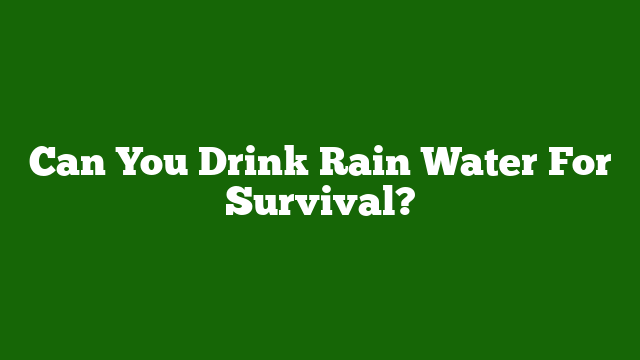Last Updated on June 12, 2023 by Umar
Rainwater, a natural resource that falls from the sky, has been used by humans for centuries.
But can you drink rainwater for survival?
In this comprehensive guide, we’ll explore the benefits, risks, and methods for collecting and purifying rainwater for safe consumption.
Benefits of Drinking Rainwater
- Natural and renewable resource: Rainwater is a natural and renewable resource that can be collected and used for various purposes, including drinking, irrigation, and sanitation.
- Low mineral content: Rainwater has low mineral content, making it soft water that is less likely to cause scale buildup in pipes and appliances.
- Environmentally friendly: Collecting and using rainwater can reduce the demand on municipal water supplies and decrease stormwater runoff, which helps protect the environment.
Risks of Drinking Rainwater
- Contamination: Rainwater can be contaminated by pollutants in the atmosphere, such as chemicals, bacteria, and viruses.
- Roof and gutter contaminants: Rainwater collected from roofs and gutters can contain debris, bird droppings, and other contaminants.
- Storage issues: Storing rainwater for extended periods can lead to the growth of algae, bacteria, and other microorganisms.
Collecting Rainwater for Drinking
To collect rainwater for drinking, follow these steps:
- Choose a suitable collection surface: A clean, non-toxic roof made of metal or tiles is ideal for collecting rainwater.
- Install a gutter system: Ensure your gutters are clean and free of debris to prevent contamination.
- Use a first flush diverter: This device diverts the initial flow of rainwater, which may contain contaminants, away from your collection system.
- Collect rainwater in a storage tank: Use a food-grade, opaque storage tank to prevent algae growth and maintain water quality.
Purifying Rainwater for Drinking
Before drinking collected rainwater, it’s essential to purify it to remove contaminants.
Here are some methods for purifying rainwater:
- Filtration: Use a water filter with a pore size of 0.2 microns or smaller to remove bacteria, protozoa, and debris.
- Boiling: Boil the rainwater for at least one minute to kill bacteria, viruses, and parasites.
- Chemical treatment: Use water purification tablets or unscented household bleach to disinfect the rainwater.
- Ultraviolet (UV) treatment: Expose the rainwater to UV light to kill bacteria, viruses, and other microorganisms.
Tips for Drinking Rainwater Safely
- Regularly clean your collection system: Keep your roof, gutters, and storage tank clean to minimize contamination.
- Test your rainwater: Regularly test your collected rainwater for contaminants to ensure it’s safe to drink.
- Use multiple purification methods: Combine filtration, boiling, chemical treatment, and UV treatment to ensure the highest level of water purity.
In conclusion, drinking rainwater for survival is possible if you collect it properly and purify it before consumption.
By following the steps and tips outlined in this guide, you can safely and effectively use rainwater as a drinking water source during emergencies or as a sustainable alternative to municipal water supplies.

